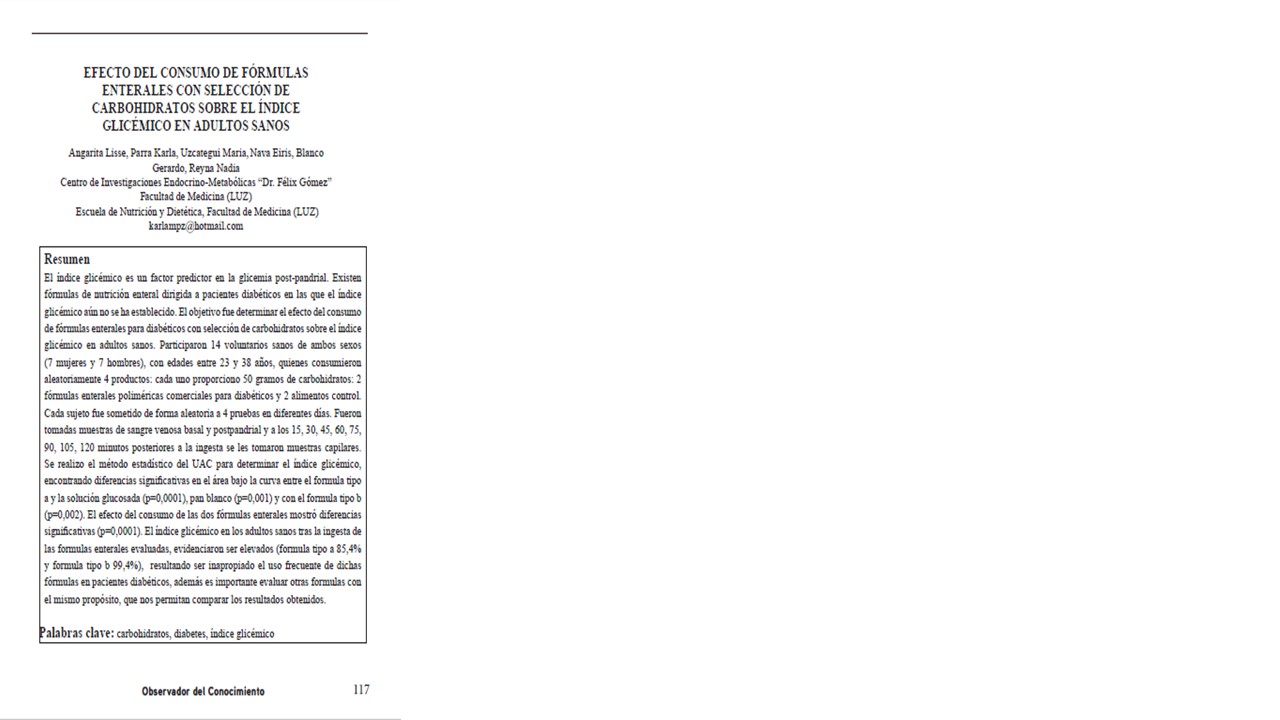Effect of Consumption of Enteral Formulas with Selection of Carbohydrates on the Glycemic Index in Healthy Adults
Keywords:
Carbohydrates, diabetes, glycemic indexAbstract
The glycemic index is a predictive factor in post-pandrial glycemia. There are enteral nutrition formulas aimed at diabetic patients in which the glycemic index has not yet been established. The objective was to determine the effect of the consumption of enteral formulas for diabetics with carbohydrate selection on the glycemic index in healthy adults. 14 healthy volunteers of both sexes (7 women and 7 men), with ages between 23 and 38 years old participated, randomly consuming 4 products: each one provided 50 grams of carbohydrates: 2 commercial polymer enteral formulas for diabetics and 2 control foods.
Downloads
References
Arteaga, L. (2006). El índice glicémico. Una controversia actual. Nutrición Hospitalaria. Chile. 132 (9).
Brackenride, B.; Campbell, R. (2008). Enteral nutritionall support and supplementation in diabetes. Diabetes Educ. 463-465.
Camacho, N.; Soto, I.; Figueroa, O.; Alvarado, J.; Correa, C.; Catillo, C. (2000). Dieta en Salud y Enfermedad. Nutricion Hospitalaria. Caracas. 35: 71-77.
Campbell, S.; Schiller, M. (2002). Considerations for enteral nutrition support of patients with diabetes. Top Clin Nut.
Edes, T.; Shah, J. (2000). Glycemic index and insulin response to a liquid nutritional formula compared with a standard meal. J. Am. Coll. Nutr.17: 30- 35.
Flint, A.; Moller, B.; Raben, A.; Pedersen, D.; Tetens, I. (2004). The use of glycaemic index tables to predict glycaemic index of composed breakfast meal. Brit. J. Nutr. 91:979-989.
Foster, K.; Holt, S.; Brand, J. (2002). International tables of glycemic index and glycemic loads values. Am. J. Clin. Nutr. 76:5-56.
Franz, MJ.; Bantle, JP.; Beebe, CA.; Brunzell, JD. (2004). Nutrition principles and recomentations in diabetes. Diabetes Care. 27(1):36-46.
Fsheard, C.; Brand, F. (2004). Dietary carbohydrate (amount and type) in the prevention and management of diabetes. Diabetes Care. 27(9):2266-2271.
Kendall, CW.; Vuksan, V. (2002). High-complex carbohydrate or lente carbohydrate foods? Am.J. Med. 113:30-37.
Méndez, C. (2001). Metodología, diseño y desarrollo del proceso de investigación (3era Ed.). (pp. 84-86). McGraw-Hill.
Morales, I.; Morales, B.; Aranda, W. (2006). Índice glicémico de fórmulas enterales de uso habitual. Revista de enfermería, American Society for Parenteral and Enteral Nutrition (ASPEN) - Febrero 12-15, Dallas, Texas, USA.
Reyes, L.; Salazar, W.; Muñoz, D.; Villalobos, Z. (2009). La investigación en ciencias de la salud: una visión integradora. Universidad del Zulia.
Colección Textos Universitarios. Ediciones del Vicerrectorado Académico.
Torres, N.; Palacio, R.V.; Noriega, L.; Tovar, A. (2006). Índice glicémico, índice insulinémico y carga glicémica de bebidas de soya con un contenido bajo y alto de carbohidrato. Revista de investigación clínica. 58:5.
Wolever, T.; Bolognesi, C. (2002). Prediction of glucose and insulin responses of normal subjects after consuming mixed meals varying in energy, protein, fat, carbohydrate and glycemic index. J. Nutr. 126: 2807-2812.

Downloads
Published
How to Cite
Issue
Section
License

This work is licensed under a Creative Commons Attribution-NoDerivatives 4.0 International License.







